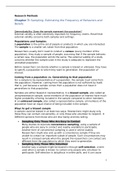Samenvatting
Summary Research Methods, Beth Morling (2018) - Chapter 7 Sampling: Estimating the Frequency of Behaviors and Beliefs
- Instelling
- Universiteit Utrecht (UU)
Samenvatting van Hoofdstuk 7 uit het boek Research Methods van Beth Morling.
[Meer zien]





